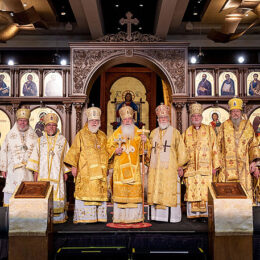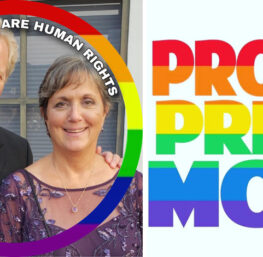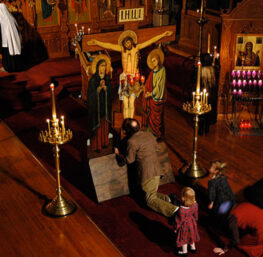7/16/2010 – Stuart Koehl –
In the pending court case for overturning California’s Proposition 8, which banned “gay marriage,” two leading conservative legal scholars face off: Charles J. Cooper, taking the classical conservative line that organic social institutions such as marriage have an inherent value and cannot be redefined by legal fiat, and Theodore Olson, taking the more libertarian line that government should simply regulate contractual relationships between individuals and not become involved in private matters.
Whichever is right—whether marriage is or is not a purely private matter in which the state has no abiding interest—the deeper and more immediate danger of the marriage issue for Christians is its potential use by gay activists to undermine the autonomy of the Church and other religious entities. If there is an inherent “right to marriage” for same-sex couples, religious groups that refuse to marry gay couples are violating their civil rights, which in turn could lead to a repeal of the churches’ tax exempt status—or a complete overturn in our law and culture of the religious understanding of marriage as a union between a man and a woman.
R. Emmet Tyrell, publisher of The American Spectator and a friend of both men, is in a quandary, and has proposed what he considers a peaceful solution to the issue:
[P]erhaps we should short circuit this tricky business. We should privatize marriage. The state merely enforces contracts between two people, a man and a woman, a woman and woman, a man and a man. Meanwhile, the churches and synagogues extend the sacrament for those who want it. Get the state out of the love and sacrament business. Everyone is happy, no?
Tyrrell has it backwards: rather than the state getting out of the “sacraments business” (which it really isn’t in), the Church should simply stop acting an agent of the state in the execution of marriage contracts. When a priest or minister says the magic words, “By the power invested in me by the State of ___,” he is acting as a civil magistrate binding the couple in the whole web of rights, duties, and obligations pertaining to marriage under civil law. His action is at one level religious, but it is predominantly legal.
Therefore, the Church becomes inextricably bound in the entire debate revolving around marriages—who can, who can’t, and under what conditions.
This has not always been the case. In the pre-Constantinian period, the Church had no legal standing, and sacramental marriage was utterly distinct from legal marriage. Even after Christianity was adopted by the Roman Empire in the fourth century, one still had to obtain a civil marriage from a magistrate before presenting himself in church for a sacramental union. A Church marriage only became one of the criteria for recognition of a union as a legal marriage in the sixth century.
Because Church and civil marriage were separate and distinct, the Church was absolutely free to follow its own doctrine with regard to marriage and its disciplines. In the patristic period, marriage was held to be an indissoluable sacrament that transcended death; therefore a person could enter into only one sacramental marriage in a lifetime.
In both the East and the West, the Church in principle upheld this ideal, and in the East, at least, did not perform “second marriages” or “remarriages” until the ninth century. Rather, when confronted by the pastoral reality of people who wanted to remarry after widowhood, or after divorce, the Church, recognized civil marriages and focused entirely on the reintegration of the remarried into the Church through prayer and fasting.
In the ninth century, however, the Emperor Leo VI abolished civil marriage within the Roman Empire and turned over total responsibility for administering marriage to the Church. The Church thus, for the first time, had to deal with the messy legal and social realities, including divorce and widowhood and the welfare of children.
To protect the integrity of its doctrine of indissolubility while meeting the pastoral needs of the faithful, the eastern Churches devised a non-sacramental “Rite of Remarriage,” which in effect took the place of a second civil marriage. Solemn and penitential in nature, it was explicitly a concession to human frailty and lacked the signs associated with sacramental marriage (in the eastern Churches, the Crowning, the singing of certain prayers, and the sharing of the Eucharist).
The situation in the West was quite different, because of the collapse of central secular authority and a somewhat different theology of marriage, but ultimately, the Latin Church also became responsible for administering all aspects of marriage, though it came to a very different solution to the issue of remarriage and divorce.
The same situation continued after the Reformation, because most Protestant states formed established churches, which, as extensions of the government, naturally functioned as government agents. And this worked because their was a general consensus between church and state on the meaning and purpose of marriage.
Even after the French Revolution severed the relationship of church and state in France and much of Western Europe, church and state still shared that consensus, but the state generally took over all the legal aspects pertaining to marriage. Only civil marriages had legal standing, and a couple would first get married before a magistrate before going to church for a sacramental wedding.
Today, the general consensus on marriage has become irrevocably broken. There are fundamental differences between the two regarding the nature and purpose of marriage, which in a secular society means, inevitably, that the state’s understanding of marriage is going to prevail, and be enforced by coercive measures.
We are reverting to the pre-Constantinian situation, where the Church has no legal standing and its doctrines are considered to be private matters (when they are not considered to be seditious). The solution is a return to the pre-Constantinian practice of the Church in which a Church marriage is a purely sacramental matter, subject to the doctrine and disciplines of the Church, but without legal standing.
Legal recognition of marriage would become a purely civil matter. A couple who wanted to marry would have to get a license and go to a civil magistrate. If they then wanted their union sacramentalized, they would go to the Church. If the Church refused to marry them because they did not meet its criteria for a sacramental wedding—if both parties were of the same sex, for example—the state could do nothing about it, since the Church is a voluntary association protected by the free exercise clause of the First Amendment.
Thus disencumbered from its role as an agent of the state, the Church would be free to teach, encourage, and set an example for the rest of the world. It would not have to worry about the legal ramifications of its actions. And this could provide the freedom the Church needs to reshape marriage in the West in a way political and legal activism will not, and cannot.
Decoupled from the state, the Church can preach the Gospel with regard to marriage and human sexuality generally, backed up by enforcement of its canonical and ascetic disciplines, without fear of state sanction—assuming the Church is willing to accept the burden of proclaiming a truth so contrary to the prevailing zeitgeist.
It will not be enough for the Church simply to surrender its role as an agent of the state in marriage; the bishops of the Church must also provide visible and courageous leadership, including setting their own house in order, regardless of the cost to their popularity and standing with the cultural elites. The Church must extend its leadership to the instruction of the ignorant, support for the weak or confused, and reconciliation of the fallen.
For, ultimately, it is not through the law that the oxymoron of gay marriage will be turned back, but by the conversion of individual human hearts. The power of the Church’s witness to truth, combined with a growing recognition of the necessity of traditional marriage and the havoc wrought by the host of “alternative relationships” will, if the Church remains faithful to her calling, lead to a return to sanity.
Stuart Koehl is a military historian and writer living in Northern Virginia. Tyrell’s “Another Peaceful Solution” can be found here.
HT: First Things



